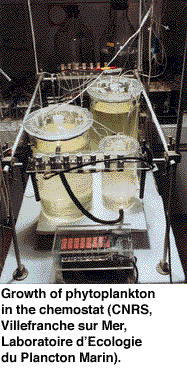The Modelling and Control of Living Resources
by Jean-Luc Gouzé
The aim of the new research team COMORE (Modelling and Control of Renewable Resources) at INRIA Sophia-Antipolis is to apply methods from control theory (feedback control, estimation, identification, optimal control, game theory) and from the theory of dynamic systems, to the mathematical modelling of living exploited resources (renewable resources) and their management. COMORE is a joint project with the CNRS Villefranche-sur-Mer. The main research themes are 'dynamics and control of fishery and aquaculture', 'modelling and control of bioreactors', 'modelling and control of phytoplankton growth', 'modelling of forest dynamics' and 'mathematics of biological modelling'.
COMORE is interested in the mathematical modelling of biological systems, more particularly of ecosystems submitted to a human action (the framework is thus that of renewable resources). It is now clear that it is important to know how to model and regulate the exploitation of these resources by man. Our conceptual framework is that of Control Theory: a system, described by state variables, with inputs (action on the system), and outputs (the measurements available on the system). In our case, the system will be an ecosystem, modelled by a mathematical model (generally a differential equation). Its variables will be, for example, the number or the density of populations. The inputs could be the actions which one exerts on the ecosystem: eg action of the man ( fishing effort, introduction of food, etc), or action of an external factor (pollution, light, etc). The outputs will be some product that one can collect from this ecosystem (harvest, capture, production of a biochemical product, etc), or some measurements (the total number of individuals for example).
This approach begins with the mathematical modelling of the system. This stage is fundamental and difficult, because one does not have rigorous laws as in physics. It is then necessary to study the properties of this mathematical system, which often has some particularities. Let us take a simple example: in reality, the variables are positive because they are populations; is it the same in the mathematical system?
One seeks to study the qualitative behavior of the system, the existence of equilibria, their stability, the existence of periodic solutions... These qualitative questions are fundamental because they tell us whether or not the model is viable (the model does not predict the extinction of any species, etc). Specific problems are posed by the biological origin of the models: functions or parameters are uncertain, or unknown; what can we say on the behavior of the model?
 It is necessary to develop
new techniques to study these problems. In the same way, the strong structure
of the models makes it possible to define classes of systems, for which
one develops adapted techniques: for example the well-known models of Lotka-Volterra
in dimension n, describing the interactions between n species.
It is necessary to develop
new techniques to study these problems. In the same way, the strong structure
of the models makes it possible to define classes of systems, for which
one develops adapted techniques: for example the well-known models of Lotka-Volterra
in dimension n, describing the interactions between n species.
Finally, we will consider problems of regulation (how to keep a variable at a given level) and observation (how to estimate the state variables from the outputs). The biological origin of the model gives new constraints for these classical problems.
Modelling of a Chemostat Growth of the Marine Plankton
We work in collaboration with the Station Zoologique of Villefranche-sur-Mer (CNRS), which developed a chemostat (small bioreactor where algae or cells grow on a substrate) fully automated and managed by computer; this system is well adapted to the application of the methods resulting from the theory of control. Our current work consists of studying and validating models of growth for the plankton in a variable environment (light, food, etc). The growth of the plankton is the basis of all the production of the organic matter of the oceans (fishes, etc); however, the existing traditional models (Monod, Droop) are often unsatisfactory. We seek to obtain models valid during the transitory stages, away from the equilibrium.
A fundamental problem is that of the validation, or invalidation, of these models: how to accept, with a certain precision, a model by comparing it with experimental noisy data ? The traditional approach, which consists of identifying the parameters of the model by minimizing a criterion of variation between the outputs of the model and the data, is often inefficient. We are developing new methods more pertinent for the biologists.
Modelling of a Bioreactor Observation and Control
Naturally, the topics above lead to the more general problem of modelling and control of a bioreactor. The bioreactors are having growing importance in many domains related to the human environment: alimentary (fermentation), pharmaceuticals (production of medicine), wastes (waste water treatment), etc. Let us mention the problem of observation in these systems, where the measurements are rare and expensive: a software sensor, or observer, is a differential system which estimates asymptotically the (unmeasured) variables of the model. It is based on the model and the outputs of the process.
Modelling of Exploited Systems (fishing, forests, etc)
The scale of the problems changes here; data are rare and noisy. We consider some important methodological problems: how to model the stock-recruitment relationship of the fish (the relationship between the number of fertile adults and eggs they produce). How does one optimize the exploitation of fisheries or forests with respect of some criteria?
For more information on COMORE, see http://www.inria.fr/Equipes/COMORE-eng.html
Please contact:
Jean-Luc Gouzé - INRIA
Tel: +33 4 9238 7875
E-mail: Jean-Luc.Gouze@inria.fr
